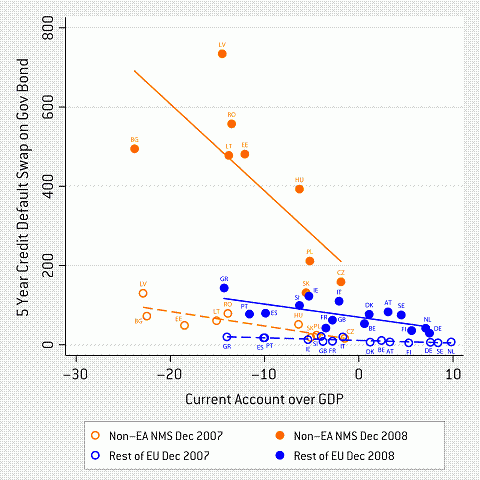Since autumn 2008, the highly successful and seemingly smooth integration, growth, and catch-up of the new EU member states of Central and Eastern Europe is suddenly looking more fragile. The financial crisis initially plagued the advanced economies of Western Europe and had little direct effect on the emerging economies - including the new member states. This was remarkable as many countries in the region exhibited significant macroeconomic imbalances (Table 1).
Table 1 FInancial integration and main macroeconomi indicators of the CEE members of the EU
| |
CA, 2002-07 |
Net FDI, 2002-07 |
Credit growth, 2002-07 |
Foreign ownership of banks, 2005 |
Share of foreign currency loans, 2007 |
Inflation, 2002-07 |
Budget balance, 2002-07 |
GDP growth, 2002-07 |
| Latvia |
-14.4 |
4.8 |
44.3 |
53.2 |
86.3 |
5.8 |
-0.9 |
9.1 |
| Estonia |
-12.3 |
6.9 |
32.7 |
99.2 |
80.0 |
3.9 |
2.0 |
9.0 |
| Bulgaria |
-11.1 |
11.6 |
33.8 |
73.0 |
50.1 |
5.9 |
1.4 |
5.9 |
| Lithuania |
-8.6 |
3.4 |
41.4 |
92.0 |
54.8 |
2.1 |
-1.2 |
7.8 |
| Romania |
-8.3 |
6.0 |
46.2 |
63.0 |
54.3 |
11.7 |
-1.8 |
6.2 |
| Hungary |
-6.9 |
2.5 |
16.7 |
82.0 |
57.1 |
5.3 |
-7.5 |
4.0 |
| Slovakia |
-5.5 |
7.5 |
8.4 |
97.4 |
20.4 |
4.7 |
-3.7 |
6.1 |
| Czech Republic |
-4.2 |
5.4 |
10.2 |
93.4 |
12.9 |
1.8 |
-4.1 |
4.5 |
| Poland |
-3.0 |
3.0 |
13.9 |
67.1 |
23.6 |
2.1 |
-4.5 |
4.4 |
| Slovenia |
-1.8 |
0.9 |
19.4 |
34.0 |
NA |
4.3 |
-1.7 |
4.0 |
Note: Countries are ordered according to their CA/GDP ratio. CA, Net FDI and Budget balance are in percent of GDP and the rest are in percent (annual average for credit growth, inflation and GDP growth). Credit growth is nominal, GDP growth is real. Source: Eurostat, IMF, ECB.
Things have changed since mid-September 2008, however, and the asymmetry between the countries who benefit from the shelter effect of the euro and those who do not divides the EU.
Like other emerging economies, the new member states are now suffering from the across-the-board repricing of risk and corresponding capital flow reversals. Furthermore, during the autumn, economies that had been largely euroised were cut off from access to corresponding liquidity by the paralysis of the euro interbank market.
Euro-area crisis management has often been perceived in Central and Eastern Europe as biased towards the interests of the financial institutions and the economies of the euro area and blamed for worsening the crisis in the region. But euro-area observers instead highlight the vulnerabilities accumulated by the non-euro-area new member states and characterise their policy responses to the crisis as inappropriate or inadequate.
In a recent paper (Darvas and Pisani-Ferry, 2008), we analyse the channels of transmission of the crisis from West to East, discuss the prospects for euro area enlargement, and offer policy recommendations.
Transmission channels
Several factors have mitigated the impact of the crisis on non-euro-area new member states: EU membership (by strengthening the new member states), western European ownership of new member states’ banks (by indirectly stabilising their new member state subsidiaries), multilateral crisis lending (by helping out Hungary and signalling the international determination to combat contagion) and repurchase agreements between the ECB and two new member states central banks (by somewhat easing the consequences of the malfunctioning euro interbank market).
Country-specific policy-induced vulnerabilities have played a role, as indicated, for example, by the correlation between the cost of credit default swaps (CDS) and current account deficits (Figure 1), and slow policy responses in some new member states also amplified the impacts of the crisis.
Figure 1. Cost of insurance against government default and the current account
Source: Authors’ calculation using data from Datastream and the DG ECFIN of the EC
But there is little doubt that policies introduced in the euro area have also contributed to asymmetry. The uncoordinated sequence of deposit guarantee upgrades may have compounded the effects of uneven credibility and flight to quality. Asymmetric liquidity and credit management by some Western European parent banks during the autumn - either in response to deteriorating economic conditions in the new member states, or as a result of commitments to maintain credit in the home country recapitalisation - was also an important channel. Banks in the new member states, especially those that are not owned by foreign banks, have faced restricted access to euro liquidity. Local currency-denominated bonds were shunned by euro-area financial institutions because they did not give access to ECB refinancing.
Finally, the current crisis also highlights the shortcomings of the EU surveillance system, since the institutional framework failed to deliver strong enough warnings to prompt timely remedial action.
So blame cannot be put on one side alone, but there are grounds for political tension.
Euro-area enlargement
Membership in the euro area is regarded by some as the solution to the problem. True, those ten of the twelve new member states that joined the EU in 2004 could by now have joined the euro area, had they met the admission criteria. Indeed, four of them are already members of the euro club. The EU can certainly be criticised for clinging to criteria ill-suited to catching-up countries and the case for reforming them is strong (Pisani-Ferry et al., 2008, Darvas and Szapary, 2008).
Is there therefore a case for speeding up? External stability concerns would suggest early euro-area entry: being inside a large currency area considerably helps small open economies in times of crisis. But the experience of the Czech Republic (not in the euro) and Slovakia (a member since 1 January 2009), two countries that have both maintained macroeconomic stability, shows that euro membership is not the key to stability. Furthermore, the arguments for caution – essentially the need to avoid imposing too low real interest rates to catching-up countries – remain fully valid.
Countries operating fixed exchange-rate systems are caught in a trap now. Given the large share of foreign-currency lending, an abandonment of the peg followed by sharp depreciation would have a devastating effect. However, under a fixed exchange rate, the reduction in current account deficits made necessary by the reversal of private capital flows will probably imply severe recession, unless domestic prices and wages are sufficiently flexible. This macroeconomic dilemma is bound to dominate policy choices, and it would not be solved by early entry into the euro area. Countries in this situation may not need to introduce a floating exchange-rate regime because of the possibility of severe overshooting, but they should facilitate real exchange-rate adjustment – where feasible, a social consensus to cut nominal wages would be less painful than other available options.
Recommendations
There are, however, possible responses other than enlargement, and we recommend that the euro area take into account its regional responsibilities. This would involve the following immediate actions:
- Swap agreements. The ECB should introduce temporary reciprocal currency arrangements (swap lines) with central banks of the new member states to provide them with euro liquidity against their own currencies, as it did for the Danish central bank and as the US Fed did for 14 central banks.
- Wider collateral. The ECB should temporarily accept as eligible securities for its repurchase transactions with counterparties government bonds issued not only in euros, but also in the domestic currencies of the new member states.
- Avoidance of asymmetric credit constraints. Governments and supervisors in Western Europe should avoid any measure that would risk causing western-owned banks in the new member states to curtail credit beyond what is justified by economic and financial developments in the relevant market.
- Policy action within the new member states. Central banks and governments in the new member states should prevent credit contraction and provide fiscal boost where budgets allow.
More permanent responses should also be discussed and implemented. In particular:
- More effective surveillance. EU surveillance has been ineffective. It should be strengthened with a view to fostering early diagnosis of vulnerabilities and remedial action.
- A level playing field. The enforcement of the EU single market and competition rules is of major importance in maintaining the integrity of the European single market.
- European financial supervision. The asymmetry in bank ownership highlighted by the crisis further underlines the need for EU-wide supervision of banks with significant cross-border activities.
- EU-wide coordination of guarantees. A permanent mechanism should be established to ensure coordination of bank deposit guarantees in the EU and to avoid an unfair advantage accruing to early movers.
Closing thoughts
We do not claim that the euro area is responsible for the severity of crisis in the neighbouring countries. For some of the channels of transmission, there is little that governments, central banks and supervisors in the euro area could have done to mitigate the crisis’s effects. Also, the new member states bear some of the blame themselves. There was widespread complacency about extremely large current-account deficits and inaction in the face of property booms. In the case of Hungary, earlier fiscal profligacy also played a role. However, other actions – or inactions –by euro-area policymakers in the heat of the crisis may have had unintended consequences.
The EU cannot be indifferent to the worsening of the crisis in the new member states, if only because it promoted openness to foreign direct investment in their banking and financial sectors. Western European ownership of new member states banks had a role in the pervasive development of foreign-currency loans to the private sector in many countries in the region, which adds to their vulnerability.
When the crisis intensified, the euro area understandably gave priority to coordinating decisions among the participant countries and with the ECB. But the euro-area institutions now need to recognise that the consequences of their actions are not confined to the currency area – they should take their broader effects into account when making decisions.
Right or wrong, some new member states now perceive solidarity to be in short supply when crisis strikes. To correct this perception, the EU needs to discuss the contentious issues openly and ensure that common, rather than divergent, conclusions are drawn. This will help avoid creating a new divide within Europe.
Editors' note: This column first appeared on Eurointelligence.
References
Darvas, Zsolt and Jean Pisani-Ferry, ‘Avoiding a new European divide’, Bruegel Policy Brief, 19 December 2008.
Darvas, Zsolt and György Szapáry, 2008, Euro area enlargement and euro adoption strategies, European Economy - Economic Papers 304, DG ECFIN, European Commission
Pisani-Ferry, Jean, Philippe Aghion, Alan Ahearne, Marek Belka, Jürgen von Hagen, Lars Heikensten and André Sapir, 2008, Coming of Age: Report on the euro area, Bruegel Blueprint.



